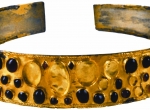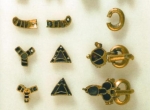Huns
Huns, a nomadic people originating from northern China and Mongolia. The earliest finds identified with the H., in the form of rich shaft tombs dating to the first centuries AD, are known from Mongolia, Altai, Kazakhstan, Tian Shan, Kyrgyzstan and the drainage basin of the Ural and the Kama rivers. The H. presumably came to Europe following a trail running to the south of the Urals, driven by increasingly frequent droughts and harsh winters. In 375 they appeared on the Lower Danube, then occupied by the Alans, whom they subjugated in no time. They were made fearsome by their speed, manoeuvrability of their horses, the tactics of feigned retreats - methods of warfare unknown to the Romans and to the people of →Barbaricum . H. burials hold distinctive objects they brought with them to Europe: reflex composite bows, long double-edged swords with an amulet in the form of a large bead of amber or a semi-precious stone, short single-edged swords, high wooden saddles, and in women’s graves, diadems of gold sheet inlaid with semi-precious stones, especially garnets, elaborate gold earrings and metal mirrors. Discovered mostly outside graves are great copper cauldrons, up to 50 kg in weight, used for sacrificial purposes. Many individuals found in H. graves have an artificially deformed, markedly elongated skull obtained through a process that took place in infancy. Next to burials there are deposits interpreted as sacrifices made to the dead which have the form of gold objects destroyed deliberately and deposited in the ground lacking traces of burial. They are known also from Europe, from the territory of the H. kingdom in Pannonia, e.g., Szeged-Nagyszéksos and Pannonhalma.
After the Alans the next to be defeated were the →Ostrogoths on the Black Sea steppes and the →Visigoths in the Roman province of Dacia, vacated by the Romans back in 275, and in Transylvania. Until the onset of the 5th century the H. remained on the Black Sea and only some of them set out for eastern Hungary and Pannonia. They became allies of the Roman military commander Aëtius; the most bloody venture of the Romans and the H. was the destruction of the →Burgundians in 436, then residing on the Middle Rhine, which event formed the historical core of the Song of the Nibelungs. For their assistance Aëtius ceded to the H. northern Pannonia between the Danube and the Drava.
An account of the H. invasion is given by the Roman historian Ammianus Marcellinus, high Roman officer and friend of Julian the Apostate, author of Res gestae in which he describes the events of the third quarter of the 4th century.
Starting from 445 the H. were ruled by →Attila alone and posed a threat to the western and the eastern empire so great that the Romans paid the H. and →Germanic Tribes enormous amounts of tribute. This is documented across the territory of the →Barbaricum , the Danubian region in particular, by numerous finds of burials and hoards of gold coins – Roman solidi →Solidus – and ornaments, some of them gold. From Szikáncs in east Hungary comes a hoard of 1438 solidi (6.5 kg of gold), from Bíňa in Slovakia, a hoard of 108 solidi (0.5 kg), which may be a part of a tribute issued to the H. by Constantinople.
A member of a Byzantine embassy sent to the H. in 449 was Priscus of Panium who described his sojourn at the court of →Attila and a feast in which the envoys took part. He recorded H. customs, their dwellings and also the appearance of Attila himself.
In 451 →Attila entered Gaul with allied Germanic troops, a force of 30,000 men. A battle was waged in the Catalaunian Plains on the river Marne, near Troyes, a hard-earned victory of the Romans commanded by Aëtius. This encounter is described in Getica, the work of the Roman historian →Jordanes written around mid-6th century. After the battle Attila withdrew to Hungary, and died a year later. In 454 or 455 the subjugated →Germanic Tribes rebelled against the H. rule and the H. were routed. A part of them settled on the territory of the eastern empire, others returned to Asia. A grave discovered in the Chinese province of Xinjiang, to the north of Tian Shan, contained objects of European origin.
In western Europe many finds attest to the sojourn of the H. or eastern Germanic tribes: the Pouan-les-Vallées warrior burial in Champagne, with a double-edged and a single-edged sword, a neckring, a heavy gold bracelet and a ring inscribed with an east Germanic name - HEVA; the Mundolsheim warrior in Alsace containing gilded silver saddle mounts; the Wolfsheim burial near Mainz, with an amber sword bead and a gold bracelet, and a fragment of another, engraved with the name of Ardashir I, d. 241, founder of the Persian Sasanian dynasty. A handful of women’s burials discovered in Normandy and Alsace held the large distinctive East Germanic brooches set with almandines, gold foil appliqués sewn onto clothing and metal mirrors.
A number of deposits discovered in Poland suggest that Silesia and Lesser Poland were under the sway of the H. Empire. From →Jędrzychowice , Lower Silesia, comes a find of a copper cauldron and a gold diadem. The rich grave from →Jakuszowice near Kazimierza Wielka held fragments of a reflex composite bow, gold horse harness fittings and a long sword with a large amber pendant. The individual buried at the nearby →Przemęczany had an artificially deformed skull. The most recent find, a grave of a thirty-year old man from →Juszkowo near Pruszcz Gdański, held a long sword, a large amber bead and a Danubian-style buckle. In Pomerania, especially to the east of the Lower Vistula, we find a concentration of hoards and single finds of solidi →Solidus, dated to mid-5th century and its latter half. They are recorded also in Mecklenburg, on Bornholm and in southern Scandinavia and thought to document the return of warriors to their homeland after the death of Attila →Attila and the Battle of Nedao.
MM
Literature: J. Werner, Beiträge zur Archäologie des Attila-Reiches. Bayerische Akademie der Wissenschaften, Phil.-Hist. Klasse, Abhandlungen, N. F. 38 A. München 1956; F. Altheim, Geschichte der Hunnen. Band I-V, Berlin 1959-1962; O. J. Maenchen-Helfen, Die Welt der Hunnen, Wien 1978; W. Menghin (ed.), Germanen, Hunnen und Awaren. Schätze der Völkerwanderungszeit, Nürnberg 1987; J-Y. Marin, Attila. Les influences danubiennes dans l’ouest de l’Europe au Ve siècle, Caen 1990; I. Bóna, Das Hunnenreich, Stuttgart 1991; I. P. Zaseckaja, Kul’tura kočevnikov južnorusskich stepej v gunnskuju epochu (konec IV-V vv.), Sankt-Peterburg 1994; K. Godłowski, Das „Fürstengrab” des 5. Jhs. und der „Fürstensitz” in Jakuszowice in Südpolen [in:] M. Kazanski, F. Vallet (eds.), La noblesse romaine et les chefs barbares du IIIe au VIIe siècle, Condé-sur-Noireau 1995, p. 155-179; B. Anke, Studien zur reiternomadischen Kultur des 4. bis 5. Jahrhunderts, Beiträge zur Ur- und Frühgeschichte Mitteleuropas 8, Weissbach 1998; D. Quast, Das „Pektorale” von Wolfsheim, Kr. Mainz-Bingen, Germania 77, 1999, p. 706-718; M. Kazanski, A. Mastykova, Les peuples du Caucase du Nord. Le début de l’histoire (Ier – VIIe siècle apr. J.-C.), Paris 2003; Pouan [in:] H. Beck, D. Geuenich, H. Steuer (eds.) Reallexikon der Germanischen Altertumskunde 23, Berlin- New York 2003, p. 325-328 (M. Kazanski); L. A. Tyszkiewicz, Hunowie w Europie. Ich wpływ na Cesarstwo Wschodnie i Zachodnie oraz na ludy barbarzyńskie, Acta Universitatis Wratislaviensis 2695, Wrocław 2004; M. Kazanski, I. Akhmedov, La tombe de Mundolsheim (Bas-Rhin): Un chef militaire Nomade au service de Rome [in:] J. Tejral (ed.), Barbaren im Wandel. Beiträge zur Kultur und Identitätsumbildung in der Völkerwanderungszeit, Spisy Archeologického Ústavu AV ČR Brno 26, Brno 2007, p. 249-261; A. Koch (ed.), Attila und die Hunnen, Stuttgart 2007; J. Tejral, Das Hunnenreich und die Identitätsfragen der barbarischen „gentes“ im Mitteldonauraum aus der Sicht der Archäologie [in:] J. Tejral (ed.), Barbaren im Wandel. Beiträge zur Kultur und Identitätsumbildung in der Völkerwanderungszeit, Spisy Archeologického Ústavu AV ČR Brno 26, Brno 2007, p. 55-119; M. Kazanski, Archéologie des peuples barbares, Bucureşti-Brăila 2009; M. Mączyńska, Światło z popiołu. Wędrwówki ludów w Europie w IV i V w., Warszawa 2013.
-
![Fig. 1. Copper Hunnic cauldron from Törtel in Hungary and a reconstruction of a saddle with gold mounts from Mundolsheim in Alsace (F. Fjulep F. Fjulep, Vengerskij Nacional’nyj Muzej [in:] Budapeštskie muzei. Budapešt 1985; J-Y. Marin 1990).](http://www.mpov.uw.edu.pl/userfiles/pl/generated/thumbs/150x110_1/Badania/Thesaurus/hunowie1.jpg) full resolution
full resolution
Fig. 1. Copper Hunnic cauldron from Törtel in Hungary and a reconstruction of a saddle with gold mounts from Mundolsheim in Alsace (F. Fjulep F. Fjulep, Vengerskij Nacional’nyj Muzej [in:] Budapeštskie muzei. Budapešt 1985; J-Y. Marin 1990).
-
 full resolution
full resolution
2. Gold Hunnic diadem from the region of Odessa. Römisch-Germanisches Museum in Cologne (A. Koch 2007).
-
 full resolution
full resolution
3. Objects from a ritual deposit for the dead from Szeged-Nagyszéksos in Hungary (W. Menghin 1987).


